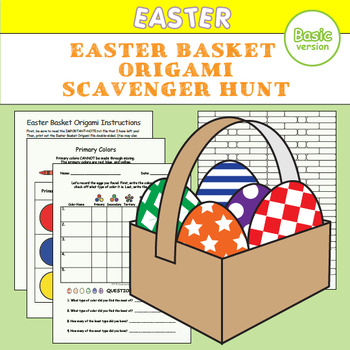Easter Basket Origami & Scavenger Hunt Craft Activity for Art, Math, EFL - Basic
- Zip
Description
Teach your students about primary, secondary, and tertiary colors in Art, practice counting and sorting in Math, or learn color names in EFL/ESL by crafting an origami Easter basket and having a scavenger hunt! After the hunt is over, have your students record and sort their eggs on one of the worksheets. Perfect for Art, Math, EFL/ESL, fine motor skills, Easter, or spring in general! =)
UPDATED! Now includes 4 worksheets, 7 information sheets, and 2 customizable templates!!
Use the information sheets to help you teach!
Use the customizable templates to add your own questions!
What do you get?
Basket
- Origami Template (8.5" x 11")
- Instructions (PDF)
Eggs
- 10 Designs
- 20 Colors
- 8 PDFs
Worksheets (4)
- Recording Sheet
- Recording Sheet with Questions
- Questions Sheet
- Sorting Mat
Information Sheets (7)
- Primary Colors
- Secondary Colors
- Tertiary Colors
- Primary Colors (Cannot Mix to Get)
- Mixing to Get Secondary Colors
- Mixing to Get Tertiary Colors
- Color & Pattern Information
Customizable Templates (2)
- Recording Sheet with Questions Template
- Questions Sheet Template
Egg Clipart
- 190 Eggs
- 1 Size
- In Color
- In Black & White
- In Grayscale
What you'll need:
- Scissors
- Tape or Glue
- Crayons, Colored Pencils, Markers, or Paint (for baskets if coloring)
Note: Because this activity is origami based, MINIMAL SCRAPS are involved! So, no need to worry about cleaning up a ton of paper when you're finished! ^_^
Primary Colors: red, yellow, blue
Secondary Colors: green, orange, violet
Tertiary Colors: red orange, yellow orange, yellow green, blue green, blue violet, red violet
Extra Colors: indigo, magenta, brown, tan, pink, gray, white, black
Patterns: solid, polka dot, stripes, pinstripes, checkers, stars, zigzags, honeycomb, gingham, and lattice
Worksheet Questions
Questions Worksheet
1. How many eggs did you find in all?
2. How many colors did you find in all?
3. How many patterns did you find in all?
4. How many primary color eggs did you find?
5. How many secondary color eggs did you find?
6. How many tertiary color eggs did you find?
7. How many other color eggs did you find?
Recording Sheet with Questions
1. What type of color did you find the most of?
2. What type of color did you find the least of?
3. How many of the least type did you have?
4. How many of the most type did you have?
Or, create your own questions using the customizable templates!
Page Count:
Basket Origami - 2 pages
Instructions - 1 page
Primary & Secondary Eggs - 10 pages
Tertiary Eggs - 10 pages
B&W Eggs - 1 page
Blank Eggs - 1 page
Worksheets - 4 pages
Info Sheets - 7 pages
Templates - 2 pages
Extra PDFs (for printing convenience) - 36 pages
Total: 74 pages
Need the color, pattern, and color type flashcards? Check out the "Full" version here!





